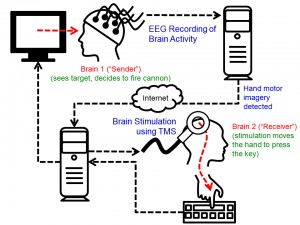Researchers at the University of Washington, Rajesh Rao and Andrea Stocco, have created a remote, non-invasive brain-to-brain interface that allowed Rao to move Stocco’s finger remotely on a keyboard using his thoughts.
“The Internet was a way to connect computers, and now it can be a way to connect brains,” Stocco said in a release. “We want to take the knowledge of a brain and transmit it directly from brain to brain.”
Rao has been working on these interfaces for a decade and brain-to-brain control has been achieved in mice using invasive techniques. This is the first time the process has been used on humans and requires a transcranial magnetic stimulation coil to be placed on the head of the subject. The user in control can then send a signal by reacting to something on a screen or in the room. A electroencephalography machine picks up the brain waves and transmits them to the subject who, in turn, mimics the motion of the controller.
Thus far the team has been able to demonstrate how to play a simple video game remotely. The controller plays in the game in one room in the lab and the sensors pick up his hand motions. The signal to initiate these motions is sent to the subject and, in turn, the subject begins mimicking the actions of the controller using the same game interface, essentially playing the game remotely without seeing the screen.
This is not mind control. The subject cannot be controlled against his or her will and neither party can “read” each other’s thoughts. Think of this as sending a small shock controlled via the Internet to trigger a fairly involuntary motion.
The researchers are planning to expand this to more complex motions and try it on other subjects in the next round of testing.

